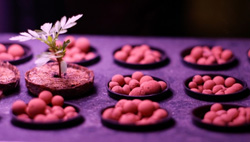by: Charlene Rennick
Soil-based gardens support plant growth because the nutrients present in the ground are absorbed by the root system inside a vehicle called water. Without water, the dry compound is ineffective in transporting food to and throughout the network of roots.
Because hydroponic systems do not use soil, the growing mediums have to be able to mimic the same process by which the plant absorbs nutrients. The growing medium for hydroponic gardens has to be porous in order to leave spaces for water and nutrients to collect.
 |
|
The key to success is to achieve a balance between too little space and too much space. If the pores are too large, the air and water will slip through too quickly and deprive the plant the opportunity to absorb the nutrients they need for growth. If the pores are too small, there are no basins in which water can be collected.
The growing medium used in hydroponic gardening is not an organic soil. The most popular alternatives used in hydroponic gardens are:
- Coir
This is the fibre from the husk of the coconut fruit. It comes in bricks which expand in size after soaking in water. It is sterile, clean and protects the plant from root disease and fungus. The colour does not transfer and does not stain clothes, carpets or any other surface.
- Perlite
These are tiny, light-weight, fluffy spheres of volcanic glass with a relatively high water content. They are clean and sterile, but are too light to be used in large-scale hydroponic plantations. They are prone to disappearing inside the water run-off and need to be replaced often.
- Clay pellets
These are PH neutral and reusable, but can stain clothes or furniture and are dusty when dry.
- Pea gravel
This convention small, round stone is clean and reusable but might be too heavy for personal, indoor hydroponic gardens.
- Rockwool
This compound is spun from molten lava into long spindly fibres. It has declined in hydroponic popularity because of the environmentally harmful emissions it produces during manufacturing.
- Perfect Starts
These cubes are a newcomer in the hydroponic market as a starter medium made from organic compost and polymer to bind it together in a malleable form. It can be used as a starting sponge to sprout seeds.
Not only are these choices better for indoor gardening than soil, but they are a conserved natural by-product from other commercial enterprises. Using the husk from the coconut uses more of the plant. Small pieces of clay, gravel and volcanic glass recycle some of the left-over substances that might otherwise go to waste.
Advantages of using alternative growing mediums in a hydroponic garden are that they are biodegradable, inexpensive, accessible for anyone to purchase and convenient to work with indoors. In addition, these hydroponic gardening bases reduce one of the biggest problems for outdoor agriculturalists: disease and pests.